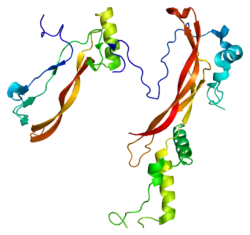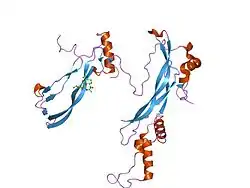ناگین
ناگین (انگلیسی: Noggin) نام یک پروتئین مهم است که در رشد و تکامل بسیاری از بافتهای بدن از جمله، استخوانها، اعصاب و ماهیچهها دخیل است و در انسان توسط ژن «NOG» کُد میشود.[3] توالی اسیدآمینهای ناگین در انسان بسیار شبیه به توالی آن در موش صحرایی، موش و قورباغه پنجهدار است.
این پروتئین نامش را از واژهٔ عامیانهٔ «noggin» به معنای «کله» یا «سر» میگیرد و به این نکته اشاره دارد که این پروتئین در صورت تجویز در غلظتهای بالا به رویان، موجب بهدنیا آمدنِ جنینهایی با سرِ بزرگ میشود.[4]
ناگین در ساختِ برخی سلولهای تخصصی مشتق از لایه زایا نقش دارد. این سلولها در اکتودرم شامل بافت عصبی، نوتوکورد، فولیکول موها و ساختمان چشم، در مزودرم شامل غضروفها، استخوان، ماهیچه و در اِندودرم شامل رشد و تکامل ریهها میشود.[5]
منابع
- "Human PubMed Reference:". National Center for Biotechnology Information, U.S. National Library of Medicine.
- "Mouse PubMed Reference:". National Center for Biotechnology Information, U.S. National Library of Medicine.
- "Entrez Gene: NOG noggin".
- Oppenheimer SB (1995). "The Discovery of Noggin". The American Biology Teacher. 57 (5): 264. doi:10.2307/4449989. JSTOR 4449989.
- Krause C, Guzman A, Knaus P (Apr 2011). "Noggin". The International Journal of Biochemistry & Cell Biology. 43 (4): 478–81. doi:10.1016/j.biocel.2011.01.007. PMID 21256973.
- مشارکتکنندگان ویکیپدیا. «Noggin (protein)». در دانشنامهٔ ویکیپدیای انگلیسی، بازبینیشده در ۲۵ دسامبر ۲۰۱۷.
بیشتر بخوانید
- Polymeropoulos MH, Poush J, Rubenstein JR, Francomano CA (May 1995). "Localization of the gene (SYM1) for proximal symphalangism to human chromosome 17q21-q22". Genomics. 27 (2): 225–9. doi:10.1006/geno.1995.1035. PMID 7557985.
- McMahon JA, Takada S, Zimmerman LB, Fan CM, Harland RM, McMahon AP (May 1998). "Noggin-mediated antagonism of BMP signaling is required for growth and patterning of the neural tube and somite". Genes & Development. 12 (10): 1438–52. doi:10.1101/gad.12.10.1438. PMC 316831. PMID 9585504.
- Brunet LJ, McMahon JA, McMahon AP, Harland RM (May 1998). "Noggin, cartilage morphogenesis, and joint formation in the mammalian skeleton". Science. 280 (5368): 1455–7. doi:10.1126/science.280.5368.1455. PMID 9603738.
- Krakow D, Reinker K, Powell B, Cantor R, Priore MA, Garber A, Lachman RS, Rimoin DL, Cohn DH (Jul 1998). "Localization of a multiple synostoses-syndrome disease gene to chromosome 17q21-22". American Journal of Human Genetics. 63 (1): 120–4. doi:10.1086/301921. PMC 1377242. PMID 9634519.
- Smith WC (Jan 1999). "TGF beta inhibitors. New and unexpected requirements in vertebrate development". Trends in Genetics. 15 (1): 3–5. doi:10.1016/S0168-9525(98)01641-2. PMID 10087923.
- Gong Y, Krakow D, Marcelino J, Wilkin D, Chitayat D, Babul-Hirji R, Hudgins L, Cremers CW, Cremers FP, Brunner HG, Reinker K, Rimoin DL, Cohn DH, Goodman FR, Reardon W, Patton M, Francomano CA, Warman ML (Mar 1999). "Heterozygous mutations in the gene encoding noggin affect human joint morphogenesis". Nature Genetics. 21 (3): 302–4. doi:10.1038/6821. PMID 10080184.
- Li W, LoTurco JJ (2000). "Noggin is a negative regulator of neuronal differentiation in developing neocortex". Developmental Neuroscience. 22 (1–2): 68–73. doi:10.1159/000017428. PMID 10657699.
- Dixon ME, Armstrong P, Stevens DB, Bamshad M (2002). "Identical mutations in NOG can cause either tarsal/carpal coalition syndrome or proximal symphalangism". Genetics in Medicine. 3 (5): 349–53. doi:10.1097/00125817-200109000-00004. PMID 11545688.
- Marcelino J, Sciortino CM, Romero MF, Ulatowski LM, Ballock RT, Economides AN, Eimon PM, Harland RM, Warman ML (Sep 2001). "Human disease-causing NOG missense mutations: effects on noggin secretion, dimer formation, and bone morphogenetic protein binding". Proceedings of the National Academy of Sciences of the United States of America. 98 (20): 11353–8. doi:10.1073/pnas.201367598. PMC 58733. PMID 11562478.
- Paine-Saunders S, Viviano BL, Economides AN, Saunders S (Jan 2002). "Heparan sulfate proteoglycans retain Noggin at the cell surface: a potential mechanism for shaping bone morphogenetic protein gradients". The Journal of Biological Chemistry. 277 (3): 2089–96. doi:10.1074/jbc.M109151200. PMID 11706034.
- Takahashi T, Takahashi I, Komatsu M, Sawaishi Y, Higashi K, Nishimura G, Saito H, Takada G (Dec 2001). "Mutations of the NOG gene in individuals with proximal symphalangism and multiple synostosis syndrome". Clinical Genetics. 60 (6): 447–51. doi:10.1034/j.1399-0004.2001.600607.x. PMID 11846737.
- Mangino M, Flex E, Digilio MC, Giannotti A, Dallapiccola B (Mar 2002). "Identification of a novel NOG gene mutation (P35S) in an Italian family with symphalangism". Human Mutation. 19 (3): 308. doi:10.1002/humu.9016. PMID 11857750.
- Brown DJ, Kim TB, Petty EM, Downs CA, Martin DM, Strouse PJ, Moroi SE, Milunsky JM, Lesperance MM (Sep 2002). "Autosomal dominant stapes ankylosis with broad thumbs and toes, hyperopia, and skeletal anomalies is caused by heterozygous nonsense and frameshift mutations in NOG, the gene encoding noggin". American Journal of Human Genetics. 71 (3): 618–24. doi:10.1086/342067. PMC 379196. PMID 12089654.
- Hall AK, Burke RM, Anand M, Dinsio KJ (Jul 2002). "Activin and bone morphogenetic proteins are present in perinatal sensory neuron target tissues that induce neuropeptides". Journal of Neurobiology. 52 (1): 52–60. doi:10.1002/neu.10068. PMID 12115893.
- Groppe J, Greenwald J, Wiater E, Rodriguez-Leon J, Economides AN, Kwiatkowski W, Affolter M, Vale WW, Izpisua Belmonte JC, Choe S (Dec 2002). "Structural basis of BMP signalling inhibition by the cystine knot protein Noggin". Nature. 420 (6916): 636–42. doi:10.1038/nature01245. PMID 12478285.
- Brown DJ, Kim TB, Petty EM, Downs CA, Martin DM, Strouse PJ, Moroi SE, Gebarski SS, Lesperance MM (Mar 2003). "Characterization of a stapes ankylosis family with a NOG mutation". Otology & Neurotology. 24 (2): 210–5. doi:10.1097/00129492-200303000-00014. PMID 12621334.
This article is issued from Wikipedia. The text is licensed under Creative Commons - Attribution - Sharealike. Additional terms may apply for the media files.

